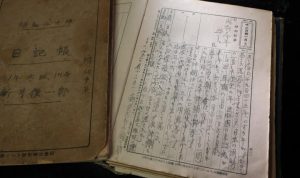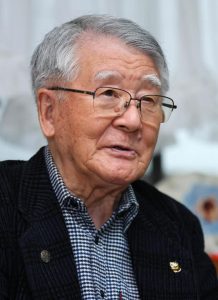Documenting Hiroshima of 1945: December 31, anti-war sentiments expressed in journal
Dec. 31, 2024
“Reborn as a new Japan next year”
by Kyosuke Mizukawa, Senior Staff Writer
On December 31, 1945, 14-year-old Shunichiro Arai, who is now 93 and a resident of Hiroshima’s Minami Ward, sent out New Year’s cards and listened to the bells rung on New Year’s Eve on the radio. In a journal he was keeping, he wrote about the end of that year. “Ah, the year 1945 ends today. The nightmare year is over.”
He was a first-year student at the junior high school affiliated with Hiroshima Higher Normal School (present-day Hiroshima University Junior and Senior High School), located in Higashisenda-machi (in Hiroshima’s present-day Naka Ward). He and other students had been mobilized to engage in agricultural work starting in July to increase food production, staying at temples and shrines in the village of Hara (in present-day Higashihiroshima City). The students had no way of knowing, but the teachers wanted to evacuate them to a safer area for fear of air raids.
Switching to belief in democracy
On August 6, Mr. Arai had been entrusted with sending a message to the school and entered Hiroshima City right after the atomic bombing. In his journal entry dated August 6, he wrote, “The entire city burned endlessly.” His junior high school building had also been burned to the ground. Some first-year students had not been evacuated from the city due to family and other reasons, and 30 students and teaching staff of the school died in the bombing.
After the bombing, Mr. Arai was evacuated for a time to Saitama Prefecture, where his grandparents lived, from his home the area of Deshio-cho (in Hiroshima’s present-day Minami Ward). He returned to Hiroshima in November and joined other first-year students, who were staying at Kyojun-ji Temple in the village of Hara and taking classes there. Due to food shortages, the children were sent to do farm work for days on the former Army drill grounds in the village.
Mr. Arai looks back on those days as a time “when I went through a drastic change, from a young person who believed in militarism to a believer in democracy.” One of the radio programs broadcast at that time, titled “Shinso wa Ko-da” (in English, ‘This is the truth’), was produced by the General Headquarters of the Allied Powers (GHQ) to promote democratization. The program touched on issues involving Japan’s politicians and military before and during the war.
Above all, he thought deeply about the misery of war. While staying at his parent’s home over winter vacation on December 24, he visited the site where his junior high school had been located. “Many friends of mine had died because of the war. I was filled with indescribable emotions,” he wrote in his journal entry dated that day.
Former classmates killed in atomic bombing
Mr. Arai had received the journal book from Yoshitora Masaki. As mentioned in an article in this series dated August 29, Mr. Masaki, then a first-year student at Hiroshima First Junior High School (present-day Kokusaiji High School), experienced the atomic bombing in the school building and died 23 days later. Another article in this series dated August 6 tells a story about Akira Kutsuki, then a first-year student at Hiroshima Municipal Junior High School (present-day Motomachi High School). He had been working on the demolition of buildings when he experienced the atomic bombing and died. The two boys were Mr. Arai’s classmates at the national school affiliated with Hiroshima Normal School’s Boys’ Division (present-day Shinonome Elementary School Affiliated with Hiroshima University).
In his journal on New Year’s Eve, Mr. Arai wrote, “From next year, Japan will be reborn as a new, free Japan.” He reread the entry and explained what he was thinking when he wrote it 79 years ago. “We young people had to do something about Japan from scratch. And I felt, ‘I’ve had enough of war.’”
In 1976, the Hiroshima City government estimated that the number of people who had died in Hiroshima because of the atomic bombing by the end of December 1945 was 140,000 victims (with a margin of error of plus or minus 10,000). People died one after another from acute symptoms of radiation sickness, including a decrease in white blood cell count and hemorrhaging. It is thought that such symptoms had largely subsided by around that time. However, the psychological and physical suffering as well as poverty experienced by A-bomb survivors continued even into 1946.
(Originally published on December 31, 2024)









